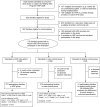Reducing maternal intimate partner violence after the birth of a child: a randomized controlled trial of the Hawaii Healthy Start Home Visitation Program
- PMID: 20048237
- PMCID: PMC2825025
- DOI: 10.1001/archpediatrics.2009.237
Reducing maternal intimate partner violence after the birth of a child: a randomized controlled trial of the Hawaii Healthy Start Home Visitation Program
Abstract
Objectives: To estimate whether home visitation beginning after childbirth was associated with changes in average rates of mothers' intimate partner violence (IPV) victimization and perpetration as well as rates of specific IPV types (physical assault, verbal abuse, sexual assault, and injury) during the 3 years of program implementation and during 3 years of long-term follow-up.
Design: Randomized controlled trial.
Setting: Oahu, Hawaii.
Participants: Six hundred forty-three families with an infant at high risk for child maltreatment born between November 1994 and December 1995. Intervention Home visitors provided direct services and linked families to community resources. Home visits were to initially occur weekly and to continue for at least 3 years.
Main outcome measures: Women's self-reports of past-year IPV victimization and perpetration using the Conflict Tactics Scale. Blinded research staff conducted maternal interviews following the child's birth and annually when children were aged 1 to 3 years and then 7 to 9 years.
Results: During program implementation, intervention mothers as compared with control mothers reported lower rates of IPV victimization (incidence rate ratio [IRR], 0.86; 95% confidence interval [CI], 0.73-1.01) and significantly lower rates of perpetration (IRR, 0.83; 95% CI, 0.72-0.96). Considering specific IPV types, intervention women reported significantly lower rates of physical assault victimization (IRR, 0.85; 95% CI, 0.71-1.00) and perpetration (IRR, 0.82; 95% CI, 0.70-0.96). During long-term follow-up, rates of overall IPV victimization and perpetration decreased, with nonsignificant between-group differences. Verbal abuse victimization rates (IRR, 1.14, 95% CI, 0.97-1.34) may have increased among intervention mothers.
Conclusion: Early-childhood home visitation may be a promising strategy for reducing IPV.
Trial registration: ClinicalTrials.gov NCT00218751.
Figures



Comment in
-
Randomised controlled trial: Early childhood home visits to high-risk families may reduce maternally perpetrated intimate partner violence.Evid Based Med. 2010 Apr;15(2):42-3. doi: 10.1136/ebm1036. Evid Based Med. 2010. PMID: 20436116 No abstract available.
References
-
- Fantuzzo J, Boruch R, Beriama A, Atkins M, Marcus S. Domestic violence and children: Prevalence and risk in five major US cities. J Am Acad Child Adolesc Psychiatry. 1997;36(1):116–122. - PubMed
-
- Campbell JC, Lewandowski LA. Mental and physical health effects of intimate partner violence on women and children. Psychiatric Clin North Am. 1997;20(2):353–374. - PubMed
-
- Bonomi AE, Anderson ML, Rivara FP, Thompson RS. Health outcomes in women with physical and sexual intimate partner violence exposure. J Womens Health. 2007;16:987–997. - PubMed
-
- Reid R, Bonomi A, Rivara F, et al. Intimate partner violence among men: prevalence, chronicity, and health effects. Am J Prev Med. 2008;34(6):478–485. - PubMed
-
- Black M, Brieding M. Adverse health conditions and health risk behaviors associated with intimate partner violence United States, 2005. JAMA. 2008;300(6):646–649. - PubMed
Publication types
MeSH terms
Associated data
Grants and funding
LinkOut - more resources
Full Text Sources
Medical
Miscellaneous

